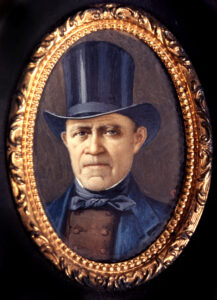Adolph Rinck
Adolph Rinck settled in New Orleans around 1840 where he was a successful portrait and miniature painter, art teacher, and sketch artist.

Courtesy of Louisiana State Museum
Judah P. Touro. Rinck, Adolph (artist)
Sophisticated and responsive to evolving tastes, artist Louis Nicholas Adolphe Rinck’s style of portraiture combined the cool precision of the influential Neoclassical painter Jacques Louis with a softer, more sentimental depiction of pious middle-class domesticity. Following his counterparts in the European Biedermeier period — including such artists as Anton Einsle, Arnold Spitzweg, and Ferdinand Georg Waldmüller — Rinck concentrated on the details of dress and interior decoration to create an aura of upper middle-class comfort. There is a tension in his work between the soft, glowing representation of flesh and more hard-edged delineation of costume and background details. Rinck’s clear, even lighting derives ultimately from influential French painter Jacques-Louis David, and he possessed an academic mastery of composition. Yet, in line with the Beidermeier style, his modeling is rather planar, with somewhat abrupt transitions. Rink built up multiple thin glazes to give the flesh a glowing, porcelain-like appearance, similar to Hippolyte Delaroche’s smooth treatment of the countenance. Rinck’s sitters often appear lost in gentle reverie, in contrast to the Neoclassical directness of John Joseph Vaudechamp or Antoine-Louis Collas.
Many of Rinck’s portraits exhibit peculiar gestures and anatomical distortions, such as in Judah Benjamin (ca. 1845), where the head floats high and small above the body and the outstretched right palm seems an odd inclusion. Pinched waists, bust lines flattened into patterns, and elongated necks, as in Mrs. Victor DeJan née Clara Abat (1841), typical of Rinck’s work, also appear in compositions by Franz Jozeph (François) Fleischbein, another “ami de M. Vaudechamp.” Like painter Charles Colson, Rinck sometimes represented limbs akimbo at odd angles, or making gestures that have an apparent undercurrent of meaning lost to contemporary viewers. Rather than being the result of the artists’ inadequacies, however, these perceived mannerisms reflect the 1840s preference for something beyond the stoic appearance of Neoclassicism. Faced with the veracity of photography, patrons in New Orleans gravitated toward a gentler, more private mode of self-presentation conditioned by the rising tides of fashion and etiquette. Rinck’s portraits thus can be seen as highly complex, visually coded representations of his clients’ values and aspirations.
Rinck was born in Metz, France, on February 26, 1802, and given the name Louis Nicolas Adolphe Rinck. His father was a Hessian officer, suggesting that German was the family’s first language. Adolphe studied at Berlin Academy in Berlin, Germany, though little is know of this period. His earliest extant paintings date to 1825. In 1835, Rinck enrolled in the École des Beaux Arts in Paris, France, to study with Thomas Couture, a leading historical painter in the Davidian camp. Fellow students included Jean-Leon Gérôme and Édouard Manet. Rinck moved to New Orleans in 1840—already in middle age and yet to establish a significant career. He followed, no doubt, in the wake of fellow academics Vaudechamp and Jacques Amans, two itinerant European portraitists who occasionally worked in New Orleans. Rinck emerged soon as prominent and successful painter, earning about $2,000 per year through the 1850s. Apart from occasional trips and a possible absence from the city during the Civil War, Rinck remained for thirty years.
Many of the most prominent citizens commissioned Rinck’s portraits, including Judah Benjamin Charles Alexandre, Charlotte Euphemie Mathilde Grevemberg, Judah Touro, and Jean Baptiste Dejan, but he also painted sensitive portraits of unheralded individuals—most famously the Free Woman of Color, New Orleans, probably representing a woman in Rinck’s employ. During the mid-1840s, he sometimes added imaginary backgrounds with mountains and other geographic improbabilities. His dramatic, hazy skies recall similar treatments in paintings by Eugene Delcroix or Joseph Mallord William Turner. Later paintings take on a more mechanical and metallic appearance, not unlike the work of his 1840s contemporary, Luigi Marie Sotta, in keeping with post-Civil War aesthetic preferences. Rinck’s example had an evident impact on New Orleans artists such as George David Coulon and Julien Hudson.
Rinck was astute in business matters, and his wife Margarette owned a shop that sold imported goods — located in the 1850s in the new Pontalba townhouse building facing Jackson Square. In 1869, Rinck bought a large property in the Algiers neighborhood of New Orleans for $8,000, paying three-quarters of the total immediately and the rest within a year. For the next ten years, the artist sought support for an envisioned model farm on his property, where poor children could learn scientific agriculture and animal husbandry, as well as painting and drawing, French and Latin, horsemanship, and dancing. Rinck published a detailed plan to bring “Happiness to Millions,” trying for years to win support from the Louisiana legislature. Disappointed, he gave notice in the press in 1871 that he would move to Europe, but he made it only as far as New York City, where he lived for the next quarter-century. Rinck died in New York City in 1895.
